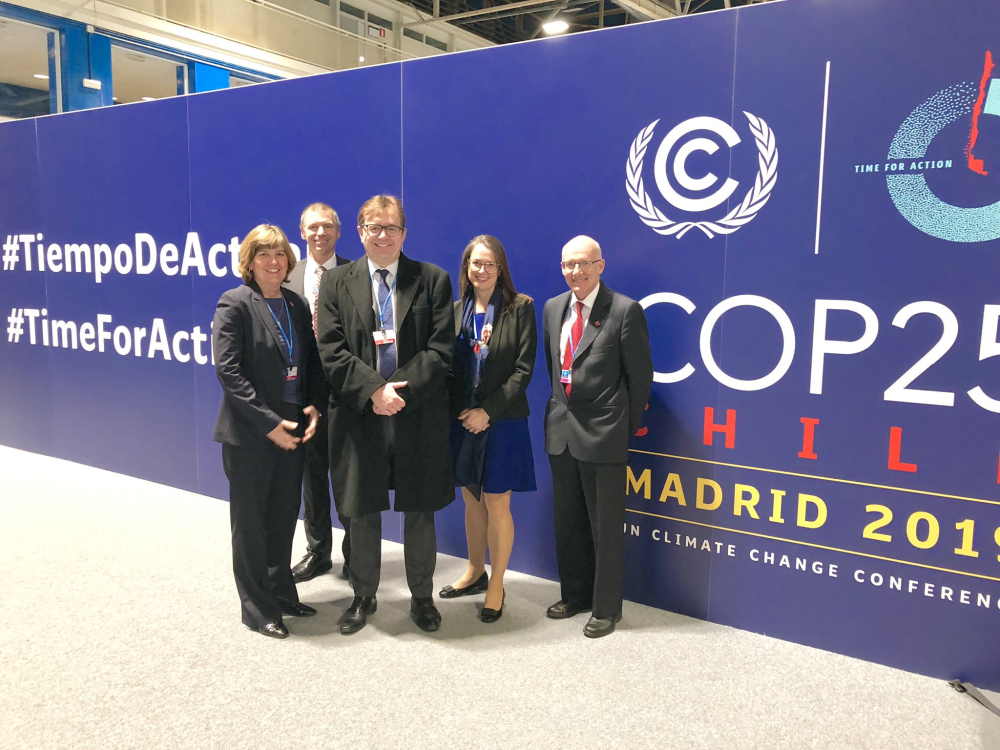Four years ago, world leaders, including Canada in a key negotiating role, gathered in Paris for the annual United Nations climate change conference to set ambitious targets and work together to avoid catastrophic climate change. Fast forward to 2019 and the outcome from that conference, the Paris Agreement, remains the world’s best hope for tackling the carbon pollution and global temperature rise that threatens the stability of our climate. As countries work to finalize the rulebook for that Agreement at this year’s conference in Madrid (COP 25), we’re looking to Jonathan Wilkinson, Canada’s newly minted minister of environment and climate change to emerge as a strong defender of the ambition of the international treaty.
We’re on the ground here in Madrid, representing the Pembina Institute, and one thing we’ll be watching closely is how negotiations unfold regarding an arcane but critical section of the Paris Agreement that was left unfinished at COP 24. Article 6 lays out a complex mechanism that will enable countries to collaborate on increasing their ambition on reducing their carbon emissions — by using what’s known as internationally transferred mitigation outcomes (ITMOs). The final form of Article 6 will have serious implications for our ability to limit average global temperature rise to 1.5 degrees Celsius to avoid planetary tipping points caused by climate change.
What’s an ITMO and why does it matter?
To put it simply, an ITMO is a carbon credit (an emission reduction that is generated from a project and that can be sold to another party). The kind of project that is eligible to generate this credit is still undefined in Article 6, but could include increasing access to solar cook stoves, or building wind farms in areas with energy poverty. If not carefully designed, ITMOs could actually undermine ambition rather than serve as an incentive to increase it. This could happen if strong rules are not put in place (and acted upon in every country) to prevent double counting, which occurs if two countries claim emission reductions from the same project toward meeting their Paris targets, or nationally determined contributions (NDCs). In this scenario, emissions would appear to be going down on paper, but in reality, they would be increasing. Countries need to agree on strong accounting rules, which is no small task, to ensure corresponding adjustments are made to prevent both parties from claiming the same reductions toward their Paris pledge. Countries will then need to operationalize these rules at home.
Another matter of debate is whether ITMOs tied to lower-carbon exports (i.e. goods produced at a purportedly lower emissions-intensity level in one region than the same goods produced in another region and/or used to displace the use of a more carbon-intensive good) should be allowed under Article 6. Of note, some federal parties, provincial governments and the oil and gas industry have suggested that emissions credits could be generated by the export of LNG to countries relying on coal, and furthermore, that these credits could be used as a path to closing the gap to meeting Canada’s 2030 carbon reduction goal. Recent projections forecast that Canada’s climate plan will come up 79 million tonnes short of our Paris target for reducing carbon pollution by 2030. These assertions ignore the long-term implications of substituting one fossil fuel with another and could greatly impact our ability to meet our own national targets. Furthermore, ITMOs for LNG exports run the risk of locking in fossil fuel infrastructure at home and abroad and diverting investment away from more cost-effective emissions reductions at home that we need to transform our economy to be competitive in a world that has come together to limit warming to 1.5 degree Celsius. Encouragingly, Minister Wilkinson recently made remarks that suggest LNG is not a shoe-in for credits under Article 6.
We expect rules regarding the use of ITMOs to follow some key principles. First and foremost, ITMOs should be used by countries to raise global ambition above and beyond their current climate commitments. For a project to be eligible to generate an ITMO, the project should demonstrate that it actually will reduce emissions, and it must be demonstrated that these reductions would not have occurred in the absence of the investment in the project, and that emissions reduced by the project have not been displaced or leaked to another location. Emissions reductions must also be verifiable. Finally, the project must protect human rights and promote the health and wellbeing of all communities.
Time to raise ambition at home
We’re expecting the Canadian delegation, including Minister Wilkinson, to demonstrate Canada’s leadership by holding the line on ambition around emissions trading and co-operative approaches to tackling climate change more broadly. This is a critical way for Canada to contribute to the global fight against climate change. And back home, Canada can turn that ambition into action. In Winning on Climate: An Action Plan for a Decarbonized Canadian Economy, we outlined recommendations for Parliament, including on the electrification of our buildings, transportation, and industry; setting accountability measures to ensure Canada hits targets; land-use decisions that reduce dependence on cars; support for the deep energy retrofit market for homes; a just transition plan that gives workers and municipalities the tools to succeed in a decarbonized economy; and ensuring Canada’s infrastructure decisions are compatible with our climate objectives.
We are a wealthy country with a diverse energy landscape, a talented workforce and a long history of innovation. We are capable of putting our heads together to not just meet but exceed our Paris pledge and put Canada on a path to achieve net carbon neutrality by 2050 and prosper in a 21st-century decarbonized economy. We expect all parties to work together to find opportunities for Canada to exceed the current Paris pledge, and set Canada on a path to achieve net carbon neutrality by 2050. Now is the time to raise ambition, to use every tool in our toolbox. The stakes are too high to leave any emissions reductions on the table.







